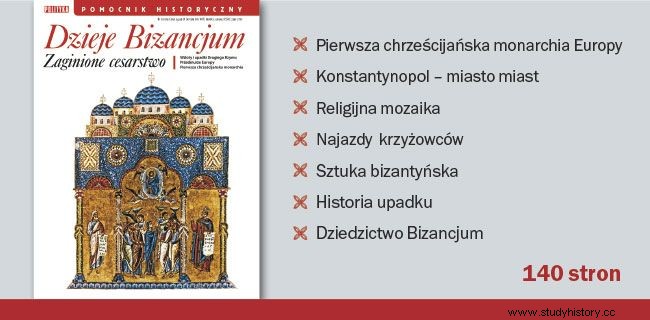None of the Byzantine monarchs fires the imagination to such an extent, none has become a symbol of such a great career, from the lowest rungs of the social ladder to the imperial purple and a real influence on power. Who was Empress Theodora?
Her face, known from the mosaic in St. Vitalis, is the most recognizable image of a Byzantine woman. And the information about her life, contained mainly in the works of one historian (Procopius of Caesarea), is astonishingly contradictory, as one story was an official historiography and the other was a drawer indictment. Who was she really?
Before she became the wife and co-author of the success of Justinian I (527–565), she had already come a long way. Born (500) rather outside the capital (Cyprus, Syria or Paphlagonia), one of the three daughters of the bear trainer Akatius, orphaned by her father early, but already in Constantinople, she worked since childhood:she was an actress in pantomime scenes, played to entertain viewers between individual races in the hippodrome. Teodora's abilities distinguished her significantly above other actresses.
Was she a prostitute, as Procopius claims? We do not know. She had an illegitimate daughter and perhaps a son. It is also known that she got into an affair with Hekebol, the governor of Libya, with whom she left for his province. Quickly abandoned, she went to Alexandria in Egypt. The stay in Africa and then the return through Antioch to the City of Cities had to broaden Theodora's horizons to a large extent, and to convince (or perhaps confirm?) The monophysical variant of Byzantine Christianity.
And it was after her return that she acquired an influential imperial nephew, Justinian, who was almost two decades older than her. She became the only love of his life (he never married again after her death, although they did not have a son; he lived in widowhood for about as many years as he was older than her).
The marriage was impeded by the law, forbidding the marriage of a member of the imperial family with the actress, and above all by the opposition of Empress Euphemia. It was only after her death that Justinian persuaded his uncle, Justin I (518–527) to make changes and was able to marry his chosen one, then twenty-something.
Augusta was for over 21 years, almost from the beginning with an independent position and influence on the authorities (she even appeared in the consistory). In 532, during the Nika rebellion (popular uprising), she literally saved her husband's life and reign, empowering him to fight for the throne.
Interested in religious matters, she consistently supported the monophysites, unlike her husband. She pushed her proteges into positions, fought her opponents. She founded churches, monasteries, hospices, sent her own messages and welcomed others. Invariably, she favored the circus faction of the Heavenly people who helped the family after her father's death. She was interested in the fate of Warsaw prostitutes.

The fascinating history of the Eastern Empire in the newest Historical Assistant of Politics - "The History of Byzantium. The Lost Empire. Click and buy on the Publisher's website .
She has proved more than once her intelligence and discernment of state affairs; Justinian praised her even officially. When she died (AD 548), perhaps of cancer, at the age of less than 50, the empire lost one of its heads.
(author:Andrzej Kompa)
More about the fascinating history of the Eastern Empire, which existed for about 1,200 years, and is associated today only with oriental splendor and excessive bureaucracy in the newest Historical Aid of POLITYKA Historia Byzantjum (from March 13 at good press outlets). The special edition will be 140 pages long, price:PLN 24.99. They will also be available at sklep.polityka.pl/
Buy from the Publisher's Store:

